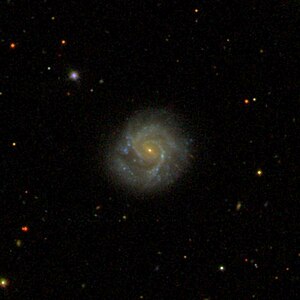NGC 236
| Galaxy NGC 236 |
|
|---|---|

|
|
| SDSS recording | |
| AladinLite | |
| Constellation | fishes |
|
Position equinox : J2000.0 , epoch : J2000.0 |
|
| Right ascension | 00 h 43 m 27.5 s |
| declination | + 02 ° 57 ′ 29 ″ |
| Appearance | |
| Morphological type | SAB (s) c |
| Brightness (visual) | 13.6 mag |
| Brightness (B-band) | 14.3 mag |
| Angular expansion | 1 ′, 2 × 1 ′, 0 |
| Position angle | 160 ° |
| Surface brightness | 13.6 mag / arcmin² |
| Physical data | |
| Redshift | 0.018823 ± 0.000037 |
| Radial velocity | 5643 ± 11 km / s |
|
Stroke distance v rad / H 0 |
(256 ± 18) · 10 6 ly (78.6 ± 5.5) Mpc |
| history | |
| discovery | Albert Marth |
| Discovery date | August 3, 1864 |
| Catalog names | |
| NGC 236 • UGC 462 • PGC 2596 • CGCG 383-080 • MCG + 00-03-001 • IRAS 00409 + 0241 • 2MASX J00432754 + 0257295 • GC 5117 • GALEX ASC J004327.57 + 025728.4 • LDCE 36 NED008 | |
NGC 236 is a spiral galaxy from the Hubble type Sc in the constellation fish on the ecliptic . It is an estimated 256 million light years away from the Milky Way and about 90,000 light years in diameter.
In the same area of the sky are u. a. the galaxies NGC 199 , NGC 200 , NGC 204 , NGC 208 .
The object was discovered on August 3, 1864 by the German astronomer Albert Marth .
